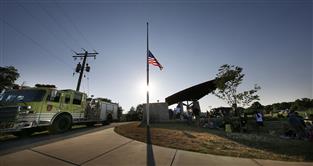John Balzer keeps his finger on pulse of Froedtert's growth
Facilities planner never short on things to do
On a recent weekday, John Balzer had 42 items on his to-do list. As vice president of facility planning and development at Froedtert Health system, the things on Balzer's list were a little more complicated than, say, changing light bulbs or fixing frayed wiring.
Balzer and his small staff oversee the things that generate, in his words, the "constant churn" of the hospital as it strives to stay ahead of a rapidly changing industry.
"We get involved in major replacements; we provide project management services for major replacements, and new (construction)," he said.
One of the big things on Balzer's mind is a $117 million expansion that will plant a 480,000-square-foot building between Froedtert's cancer center and one of its three parking structures. The building will allow for consolidation of surgical and interventional care areas on a single floor, and will house transplant and cardiovascular care centers, among other services.
This project follows the 2008 completion of the hospital's $95 million cancer center, noted for its "hub" model of care, which brings physicians to the patient, rather than the patient to physicians. The hub design was the product of "almost a year thinking about the model of care, (including) input from customers, patients, visitors, staff, physicians, nurses - everybody," all of them striving to arrive at "the best way to provide care for cancer patients … that's also affordable and efficient," Balzer said.
Building on a vision
Pulling together the many interests and the myriad details involved in renovation or new construction in the widespread hospital system is Balzer's day-to-day work.
Balzer, 61, is an engineer with a degree from Milwaukee School of Engineering who lives in Wauwatosa. Hired 32 years ago, he was among the first 50 employees taken on by Froedtert, and has seen and in a significant way helped direct the full evolution of the institution from a single building to the sprawling campus it is today.
"I think he is visionary. I think he challenges us to stay ahead of growth. I think he's innovative. He helps us design things in a way that looks to the future, looks to what patients would prefer," said Kathy Bagemihl, Froedtert's vice president of ambulatory services, who has worked with Balzer on specific projects and on long-range planning.
Balzer's staff is made up of three other project managers, an administrator who manages the office and a data manager.
Froedtert Health includes Froedtert Hospital, 9200 W. Wisconsin Ave., St. Joseph Hospital in West Bend, Community Memorial Hospital in Menomonee Falls, more than 30 clinics and several offsite facilities. Including projects in all the locations, Balzer's list fluctuates from 35 or so items to as many as 70. Throughout the system, there are about 50 projects under way at any given time, he said.
Understanding the need
While big hospital projects are complex almost by definition, smaller changes can be challenging as well. A recently completed electrophysiology room provides an example.
Electrophysiology involves fixing electrical problems - as opposed to "plumbing" problems - related to the heart. Electrical problems sometimes are caused by connections of tissue that shouldn't be connected, causing the heart to race.
Among veins, "all roads lead to Rome," that is, the heart, said Balzer, and using a catheter, a physician can follow a vein up to the heart and cauterize, or burn away, the connection that is causing the problem.
The hospital had an existing EP lab, with older technology. It "was a very, very busy room, and the decision-support people put the data together that said we've got to get more capacity in EP."
At the same time, caregivers were aware of new technology that would improve the delivery of care.
The new technology includes a biplane imaging system that allows a physician to follow the progress of the catheter on a large monitor in not just one dimension, but a view that approaches three dimensions.
In addition to a basic single-plane image, side-to-side scanners attached to either end of a bowed arm, like a room-sized set of headphones, are moved into place by means of a track in the ceiling, and show the area of care from that additional perspective.
The size of the new technology drives the size of the room, Balzer said.
Functionality is key
When a project is approved through a rigorous, weeks-long vetting procedure, Balzer's team begins a six-to-10-month bidding and planning process.
A place for the new room had to be found, so an inpatient procedure function was moved, and the space gutted. Designing the new space and placing the machinery within it involved 3-D computer modeling on a large screen, followed by the construction of a full-sized mock-up of the room.
"That's cheap and easy to do - cardboard and plywood. It's not always aesthetically pleasing, and we spray paint on the floor where the equipment is. We do cardboard cutouts, even, like, of the clock, and tape them up on the wall," he said.
Physicians and caregivers are brought in on the process.
"They're the ones who say, you know, we really need to have this cart in the room … so where is that gonna go?" Balzer said.
"We go so far as to simulate bringing a patient into the room on a cart, make sure the cart can get into the room next to the equipment, so you can move the cart to the table," Balzer said.
When the actual room is framed, "we bring all those cardboard cutouts back in and put them up, and just parade people through the room one more time," he said.
The final product in this case is a room of about 25-by-32-feet with gleaming new technology, a separate control room, a small side room containing backup power systems and other utilities, and, above it all, beyond the ceiling, the exact footprint of the room "packed with stuff," such as wires, ducts and so forth, Balzer said.
It's a $5 million job completed - a relatively complicated project among those on Balzer's list, he said. Still, nothing like the $117 million expansion.
More from News and Features
- Anodyne Coffee plans to open location in Wauwatosa Village
- Wauwatosa Meetings: Aug. 4
- Video: Wauwatosa girl's curbside ice cream stand raises money for the hungry
- Wauwatosa News and Notes: Hands-only CPR training offered; Firefly Art Fair is Aug. 6-7
- Wauwatosa Ask Now: Why are there barriers and fencing along the North Avenue bridges over the Menomonee River?
- Mystery Photo Contest: July 28
- Wauwatosa gears up for National Night Out event, this year at the zoo
- Election 2016: Wisconsin's 4th District candidates weigh in
- Wauwatosa's Luther Manor residents share smiles through flower delivery
- Wauwatosa Police Report: July 17-23














